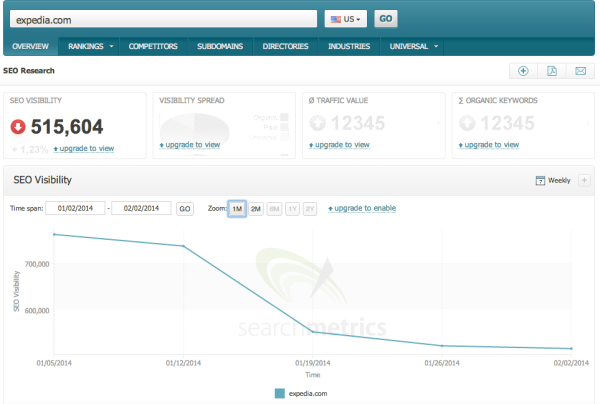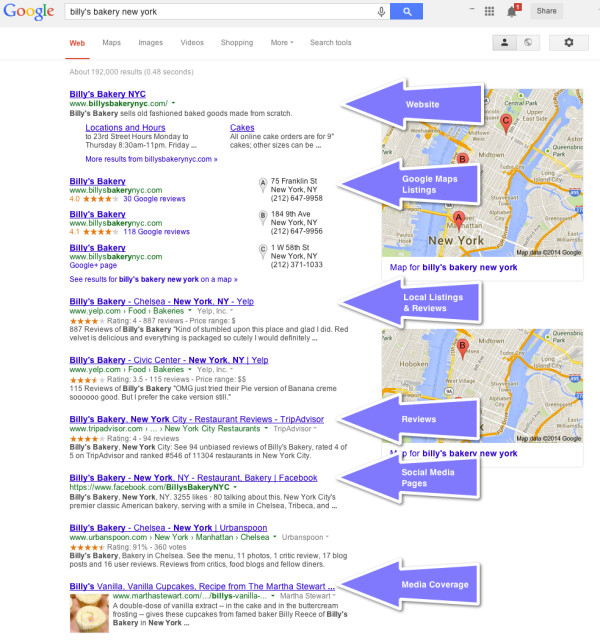We all know that a key component of any small business’ marketing strategy is to effectively position its brand in search engine results. But is it possible to dominate search results with content you control — or at least content you’ve influenced?
The answer is yes. There are simple and effective ways to boost visibility for your business in search results, while simultaneously improving related marketing efforts in social media, ratings and reviews, and media outreach.
Take a look at my six tips for local SEO success, along with action items for each in order to successfully implement them. Throughout, I’ll reference some great work done by Billy’s Bakery, a New York bakery chain, which has utilized many of these tips to dominate their search results with positive content and coverage.
1. Properly Optimize Information On Your Business’ Website
Your website is your most important and valuable online asset, so ensuring that it is properly optimized to appear high within search results is key.
Action items:
• Create a domain name that reflects your business type and its location. For example, Billy’s Bakery uses the domain “billysbakerynyc.com,” which includes it all.
• Add keywords on page titles that identify with your business, its services and its location.
• Incorporate your business’ name, address and phone number (NAP) information in not only the homepage or contact page, but each individual page of your website.
• In addition to highlighting your offerings, ensure your website copy includes as much about your local area as possible to further associate your business with the nearby vicinity. For example, note what section of town you’re in, what sports team plays across the street, or what park is around the corner. Not only will this added info help improve your website copy for customers, it will also boost your search visibility as a local business.
2. Secure, Build Out And Update Your Business Listings On Local Websites
Perhaps one of the most effective ways to boost local SEO is to ensure the availability and consistency of your business’ listing information across a myriad of third-party sources. Google and other search engines constantly scan these sites to develop a stronger understanding of the local web and your business.
When your business isn’t listed — or the information listed about it is incomplete or inaccurate — there is a risk of diminishing or negatively impacting your business’ placements in search results.
Action items:
• Search leading local listings websites ranging from Dexknows, Facebook, and Googleto Yelp, YP and Yellowbook to ensure that your business is listed, that you have “claimed” your listing, and that the business name, phone and address posted are consistent and accurate. Make changes as necessary and delete duplicate pages. As in the Billy’s Bakery example above, local sites like Google+, Yelp and TripAdvisor hold a lot of weight in search results, so it’s important to get it right.
• Build out your listings with photos, videos, website URL and other key information to make your listings more informative and attractive to potential customers.
• Ensure that your business is listed in the appropriate categories so it can be properly optimized. Relevant keywords in the business name help too. As I noted earlier, “Billy’s Bakery NYC” includes both the business type and location. However, don’t overdo it with unnecessary keywords in the business name (e.g., “Billy’s Bakery Cookies Cakes Hot Chocolate”), or search engines will take note and it will negatively impact your results.
• To further your efforts, work with a top listings provider such as Neustar Localeze or Acxiom to automate the process of securing and updating your listings across the broad ecosystem of local sites.
• If your business has multiple locations, create separate listings for each location on your website to boost the visibility of both your brand and each of your stores. The search results for Billy’s Bakery highlight the business’ three different locations individually.
3. Ensure An Appropriate Link Strategy
Links from your website to other related websites, and vice versa, play a role in your business’ SEO visibility, because they help to establish the authenticity and credibility of your business. But trying to game system by leveraging unrelated links will damage visibility over time.
Action items:
• Consistently share links to your website via your Facebook, Twitter and other social media channels, and encourage others to pass along the information as well.
• Include links to your website in email newsletters and other updates to customers.
• Host or sponsor local events, or provide discounts for neighborhood students, and then encourage neighborhood businesses, the local chamber of commerce, charity organizations and other partners to link to your website when talking about those activities.
• Create a local directory of community resources including your favorite nearby restaurants, stores and cultural attractions, to provide an opportunity for you to link out to others (and for them to return the favor). Even consider starting a blog where you can talk about your business’ neighborhood and link to businesses and places of interest.
• However, be sure that your link strategy is authentic in that you know who you are linking to and that they have relevance to your business. Also, do not create link schemes like spamming your business’ domain name on websites, forums or blog comments. Be wary of third-party content providers who claim that they can improve your SEO by writing content for your blog with SEO boosting links. These activities have the potential to damage your credibility with search engines and negatively impact your visibility in search results, as Google recently warned.
4. Encourage And Respond To Online User Reviews
User reviews help to build your business’ visibility in local search results, and so does your engagement in responding to them — whether they are positive or negative. However, small businesses need to ensure the reviews themselves always come from the outside.
Action items:
• Encourage your customers to leave ratings and reviews of your business if they are satisfied with your work. Whether it’s a simple email after a service is rendered, a flyer at checkout, or a callout on your website – the more positive, authentic reviews your business receives, the better your business will appear in search (both via the search engines and the local review sites themselves).
• As part of your encouragement, provide customers with a variety of sites to post reviews so the spread is diverse across multiple key local sites.
• Be proactive about responding to all types of user reviews. If the post is positive, thank the customer for their feedback and encourage them to use your services again. If the post is negative, explain that you appreciate the feedback and ask the customer to get in contact with you about their concerns so you can address their problems.
• Whatever you do, never post false reviews! When discovered – and they usually are, because they’re transparent – you will either lose your visibility in search, or your visibility will not be the kind you want.
5. Engage Regularly Via Social Media
Social media pages play a notable role in local business’ visibility in search results. The more proactive your social media strategy, the higher likelihood your pages will attract followers — and in turn, appear within search.
Action items:
• Develop a strong social media strategy that engages customers via Facebook, Google+, Twitter, Pinterest, Instagram and other popular networks on a regular basis. The more followers and engagement you receive, the higher your pages will appear in search. Note Billy’s Bakery’s Facebook page in the business’ search results above.
• Some ideas for engagement include updates on new products, promotions and giveaways, and highlighting stories of relevance to your customers. Be sure to respond to those reaching out via social media with questions or feedback on their orders.
6. Drive Media Coverage
Media coverage of your local business — especially from highly credible news websites — can result in a long-term positive impact on your business’ search results. For example, MarthaStewart.com’s coverage of Billy’s Bakery above appears high in its search results. Coverage like this can drive even more business to your brand, especially because it’s coming from a reliable, third-party source.
Action items:
• Develop relationships with local media and bloggers by encouraging them to take advantage of your products or services. If you’re a restaurant, send over your popular pizza to your city’s local foodie blogger. Or email a reporter about a charity event that you’re sponsoring that will benefit the local community. Your PR efforts can result in positive articles, videos or other types of coverage that will remain highly visible in search over the long-term and boost your brand’s reputation.












